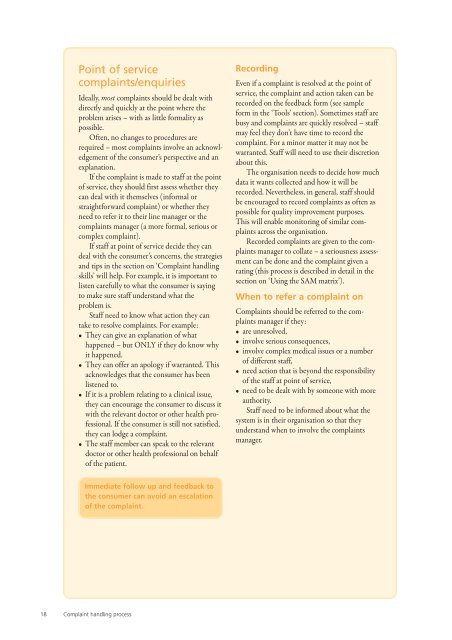Guide to Complaint Handling in Health Care Services
Guide to Complaint Handling in Health Care Services
Guide to Complaint Handling in Health Care Services
Create successful ePaper yourself
Turn your PDF publications into a flip-book with our unique Google optimized e-Paper software.
Po<strong>in</strong>t of service<br />
compla<strong>in</strong>ts/enquiries<br />
Ideally, most compla<strong>in</strong>ts should be dealt with<br />
directly and quickly at the po<strong>in</strong>t where the<br />
problem arises – with as little formality as<br />
possible.<br />
Often, no changes <strong>to</strong> procedures are<br />
required – most compla<strong>in</strong>ts <strong>in</strong>volve an acknowledgement<br />
of the consumer’s perspective and an<br />
explanation.<br />
If the compla<strong>in</strong>t is made <strong>to</strong> staff at the po<strong>in</strong>t<br />
of service, they should first assess whether they<br />
can deal with it themselves (<strong>in</strong>formal or<br />
straightforward compla<strong>in</strong>t) or whether they<br />
need <strong>to</strong> refer it <strong>to</strong> their l<strong>in</strong>e manager or the<br />
compla<strong>in</strong>ts manager (a more formal, serious or<br />
complex compla<strong>in</strong>t).<br />
If staff at po<strong>in</strong>t of service decide they can<br />
deal with the consumer’s concerns, the strategies<br />
and tips <strong>in</strong> the section on ‘<strong>Compla<strong>in</strong>t</strong> handl<strong>in</strong>g<br />
skills’ will help. For example, it is important <strong>to</strong><br />
listen carefully <strong>to</strong> what the consumer is say<strong>in</strong>g<br />
<strong>to</strong> make sure staff understand what the<br />
problem is.<br />
Staff need <strong>to</strong> know what action they can<br />
take <strong>to</strong> resolve compla<strong>in</strong>ts. For example:<br />
• They can give an explanation of what<br />
happened – but ONLY if they do know why<br />
it happened.<br />
• They can offer an apology if warranted. This<br />
acknowledges that the consumer has been<br />
listened <strong>to</strong>.<br />
• If it is a problem relat<strong>in</strong>g <strong>to</strong> a cl<strong>in</strong>ical issue,<br />
they can encourage the consumer <strong>to</strong> discuss it<br />
with the relevant doc<strong>to</strong>r or other health professional.<br />
If the consumer is still not satisfied,<br />
they can lodge a compla<strong>in</strong>t.<br />
• The staff member can speak <strong>to</strong> the relevant<br />
doc<strong>to</strong>r or other health professional on behalf<br />
of the patient.<br />
Record<strong>in</strong>g<br />
Even if a compla<strong>in</strong>t is resolved at the po<strong>in</strong>t of<br />
service, the compla<strong>in</strong>t and action taken can be<br />
recorded on the feedback form (see sample<br />
form <strong>in</strong> the ‘Tools’ section). Sometimes staff are<br />
busy and compla<strong>in</strong>ts are quickly resolved – staff<br />
may feel they don’t have time <strong>to</strong> record the<br />
compla<strong>in</strong>t. For a m<strong>in</strong>or matter it may not be<br />
warranted. Staff will need <strong>to</strong> use their discretion<br />
about this.<br />
The organisation needs <strong>to</strong> decide how much<br />
data it wants collected and how it will be<br />
recorded. Nevertheless, <strong>in</strong> general, staff should<br />
be encouraged <strong>to</strong> record compla<strong>in</strong>ts as often as<br />
possible for quality improvement purposes.<br />
This will enable moni<strong>to</strong>r<strong>in</strong>g of similar compla<strong>in</strong>ts<br />
across the organisation.<br />
Recorded compla<strong>in</strong>ts are given <strong>to</strong> the compla<strong>in</strong>ts<br />
manager <strong>to</strong> collate – a seriousness assessment<br />
can be done and the compla<strong>in</strong>t given a<br />
rat<strong>in</strong>g (this process is described <strong>in</strong> detail <strong>in</strong> the<br />
section on ‘Us<strong>in</strong>g the SAM matrix’).<br />
When <strong>to</strong> refer a compla<strong>in</strong>t on<br />
<strong>Compla<strong>in</strong>t</strong>s should be referred <strong>to</strong> the compla<strong>in</strong>ts<br />
manager if they:<br />
• are unresolved,<br />
• <strong>in</strong>volve serious consequences,<br />
• <strong>in</strong>volve complex medical issues or a number<br />
of different staff,<br />
• need action that is beyond the responsibility<br />
of the staff at po<strong>in</strong>t of service,<br />
• need <strong>to</strong> be dealt with by someone with more<br />
authority.<br />
Staff need <strong>to</strong> be <strong>in</strong>formed about what the<br />
system is <strong>in</strong> their organisation so that they<br />
understand when <strong>to</strong> <strong>in</strong>volve the compla<strong>in</strong>ts<br />
manager.<br />
Immediate follow up and feedback <strong>to</strong><br />
the consumer can avoid an escalation<br />
of the compla<strong>in</strong>t.<br />
18 <strong>Compla<strong>in</strong>t</strong> handl<strong>in</strong>g process

















